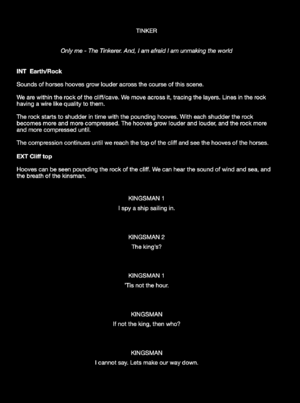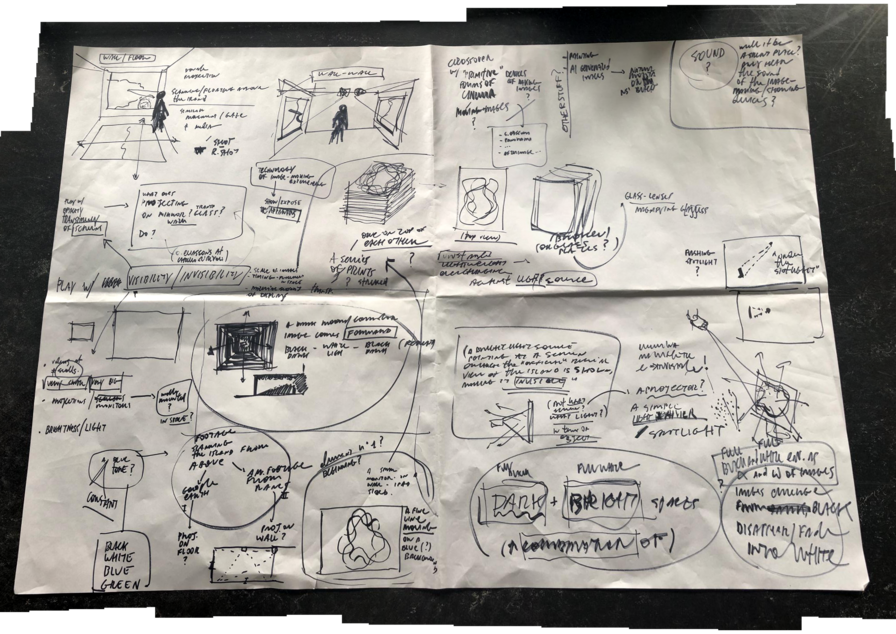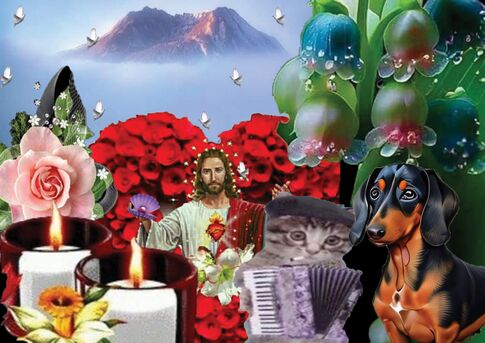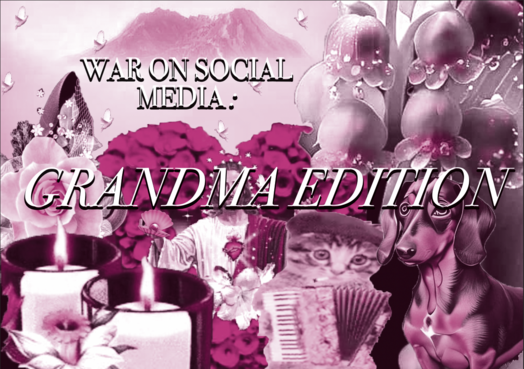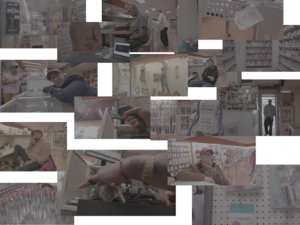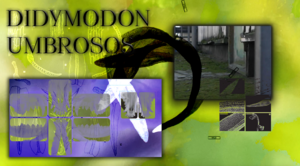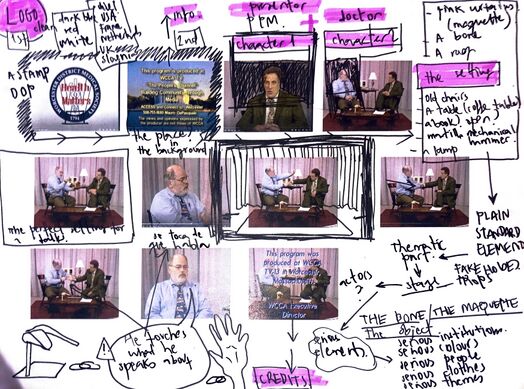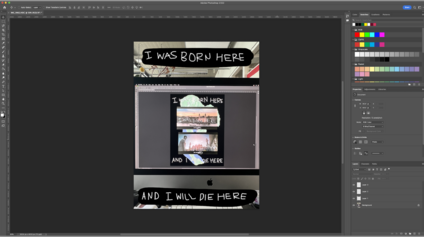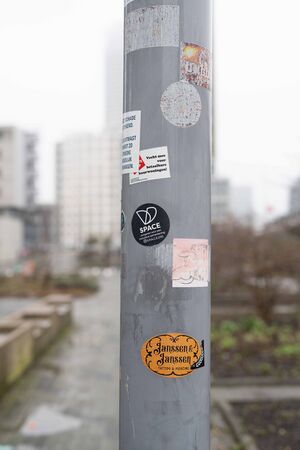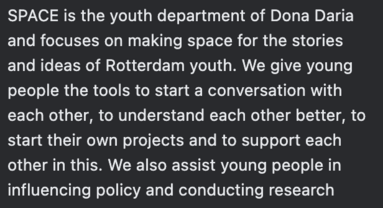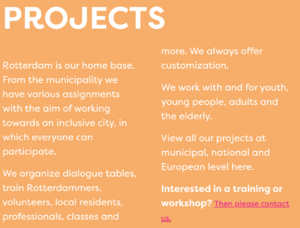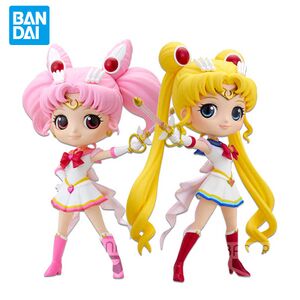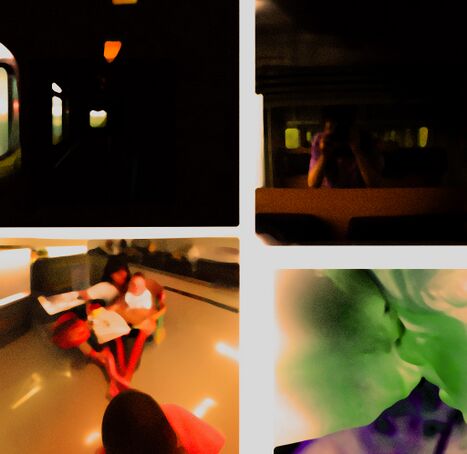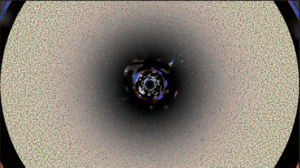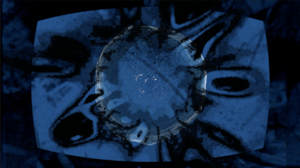PROJECT THAT MAY OR MAY NOT GET MADE
Lens Based
Arabella
V1
Will You Meet Me Here (Part II)
Using prose, music, actors, 3D modelling, video and digital interaction software, Will You Meet Me Here (Part II) invites audiences to enter a cave wherein lies the forgotten futures and histories of technology; and the people who have always and continue to resist - insisting on keep the door of imagination open. I aim for this work to be 10-15 minutes in duration.
Why make it?
I want this work to carve out a space to resist and reveal the power dynamics that are shaping our imagination around technology. As an artist, I think we can use our sensitivities to be aware of when an imaginary around any subject matter is being hijacked. Currently, this subject matter is my primary concern due to the discrepancy between the potential these technologies have to effect the lives of everyone and the small group of people who yield the power.
Workflow
I would like to split the project into _ stages: research/sketching, writing, shooting, editing and detailing. The research stage consist of two sections: reading/watching/listening and sketching (i.e. developing the content and aesthetic of the work). Following this is a writing stage, which is where I will decide on the script. Then shooting/creating, this will consist of live action, digital animating and potentially coding. Lastly, the editing period - which will also be the point where I invite feedback and focus on details. Make a timetable for the project
Timetable
START: Now
24th May - June 4th: Research
June 5th - June 23rd: Script Writing
June 23rd - August 1st: Shooting
August 1st - September 11th: Editing/Detailing/Feedback
END: 11th September
Rapid prototypes (scratches)
SCRATCH 1
SCARTCH 2: Draft some audio for the opening scene File:Scratch Audio.mp4
SCRATCH 3: using blender create a rock material and engrave it with some text from the scene above.
V2
Previous practice (use material from text on practice)
Reading an interview with Cyprien Gaillaird, something very simple struck me “I tried to imagine how that site would look through the goggles, the crystal world, and look at ancient things through this prism of technology.” (link).
Reading this helped me develop a ‘how would it look if…’ approach. Often I find myself deep in research, and sometimes it can become a very closed space. Now, I puncture this research through this question “how would it look if…’. For example, in my Text On Pratice I wrote “each scene was a geological layer in the cliff, and the cave was what made these layers visible. The cave allowed the story to be told.”. I’m now asking myself, how can I further develop this - how would the cave tell this story? What would it choose to tell, how would it speak…what would it show? These are the questions I’m now beginning with. I am building this approach around the title of Electronic Geology.
Relation to a wider context (no more than three sentences)
I continue to relate my practice broadly with the storytelling traditions (cinema, dramaturgy, prose, gaming etc.). But more specifically, I am engaging with the concepts such as existential risk and theories of technology. Even more specifically, the role of image makers and storytellers in the history and future of technology.
What was the biggest CHOISE you made in relation to your work this year? ; as in: "this year I chose..."
I’ll cheat and give three choices. This year I chose to:
- Work with sound/music as an essential part of the practice
- Centralise and develop my writing practice.
- Recognize what gives me joy to do, and build my practice/workflow around that.
Yalou
Eva (Video Documentary, duration 10 to 15 minutes) will be about the connections to my grandmother,Eva; her music (she was a piano teacher and wrote her own music), and the Hungarian culture (she fled to The Netherlands in 1956 because of the Hungarian Revolution). The piece will chart the different connections that my mother, brother, uncle and me have with the meaning of Eva. And how we feel that this connection and the being of my grandmother still has influence on our lives now.
Why make it?
I feel that this is an opportunity for me to connect with my roots and ancestor(s). It is a connection that has always been there but has never been explored. I am curious to what the dive into this personal connection will develop for me and others.
Workflow
Stage 1: At first I have to go through all the family archival footage, my grandmother's written letters and her written music.
Stage 2: This upcoming summer I will be visiting Budapest and film what once was my grandmother’s home, school and living environment.
Stage 3: And than the most important voice is her music and how we connect to that, my brother is diving into that with me.
Stage 4: This whole process will be recorded, just like all the conversations that I will have throughout it.
Timetable
June: Go through the archival footage, Making music with brother and start conversations
July: Visit Budapest, Start selecting archival footage, Making music with brother and have conversations
August: Making music with brother, have conversations, start editing FINISH: Visiting Budapest
September: Making music with brother, Have conversations, Editing, Start structure first edit FINISH: Go through the archival footage.
Oktober: Making music with brother, Have conversations, Editing
November: Finishing up the music, Have conversations.
December: Have conversations
FINISH: Finish music, Finish first edit …. … … … May: Final edit of the documentary.
Rapid prototypes (scratches)
1.Find archival footage that fit the connection to a someone (my grandmother Eva)
2. Use piano recording to write a poem about connecting
3. Edit the found archivel with existing archival and the music
1.https://youtu.be/Kh5wO7r0uxI
2. Poem is in Dutch:
Het is allemaal bedacht, fladders in mijn hoofd.
Jouw realiteit is te zien, in alles wat is bewaard.
Maar nu spreek ik voor jou, want jouw zijn is zo aanwezig.
liefde
angst
Voel
hoor
De noten die spreken.
Genoeg om te maken.
Dit is geen verering
Dit is het zijn, het zijn van ons.
De keuzes die zijn gemaakt
Want we zijn verbonden.
Allemaal verbonden.
En we zijn benieuwd
Naar de wereld die onze banden heeft gelegd.
En we zijn benieuwd
Naar het effect van de wereld op onze banden.
Dit is het zijn.
De maak van wat voelt.
De maak van het nu.
Dat verbonden is met toen.
Maar misschien allemaal bedacht als fladders in mijn hoofd.
3. https://youtu.be/berqeeIXunM
Claudio
Images from a desert island (VERY BAD TITLE, i'll think of something better)
What?
A multimedia installation in an exhibition space about North Sentinel Island. [Steve: what will we see? (describe some of the images)] It will be made of a series of excerpts - mostly short moving images pieces, but not exclusively - that were produced in the research process. It will be displayed as a fragmented yet cohesive body of work, in different media - projections, monitors, prints, … - that tries to give a sense of what the project is about and what are the tools that I have been using in it. [what kind of role are you taking on as an artist in this exhibition? are you presenting it as documentary / speculative work ? What will the narrative?] [will you use excerpts of your EYE film? ] >> will be a critique on the violence and the power dynamics that envolved in making images on this place.
Why make it?
I want to make it as an intermediate stage between the early phase of the research that I have been carrying so far and its final outcome, that I still imagine as a one-screen film piece. I feel the need to bring together in a temporarily stable form all the different bits and pieces that this research project has been unfolding, to make sense of their mutual connections and to get a more clear idea of the direction that the project will follow. Ultimately, I would like to have a chance to experiment with possible ways of bringing my research and thoughts outside of my computer/studio/head, showing it in a space and seeing the way it can affect an audience. I think it is a wonderful idea to place the research and all of your work outside of the studio / your head. Do you have any examples of exhibitions / art works / installations that you might drawn inspiration from to build your installation?
Workflow:
Make a selection of the most important elements/excerpts of the research that I feel I want to share with the audience. Make sense of their mutual relation and devise ways to make them visible/understandable/appealing to an audience. Find a space and spend time experimenting ways to bring these elements in it - think of spatial relations, dimensions, time/space experience. Open it to the public, get feedback, learn something from it, carry on the project towards its next steps. [ what are strategies that you can implement to make the research visible / understandable / appealing to an audience ?]
Timetable:
Select fragments/parts of research that I want to display in the installation. Make maquettes, draw plans, write notes about the form that the installation could take, about the way these elements could possibly inhabit and make sense together in an exhibition space. Try to find a suitable space. And find a good compromise between my plans to its physical constraints. Find someone who can deal with the practicalities of organizing an exhibition. Make the exhibition. [ what type of space do you envison the work to be exhibited? ]
Rapid prototypes (scratches)
SCRATCH - gather ideas about the elements of this installation; imagine their forms, their devices, their possible ways of being in a physical space; take notes, draw sketches to keep track what you come up with.
VERSION 2
Images from a desert island (still not the most brilliant title, still working on it)
A multimedia installation in an exhibition space about North Sentinel Island. It will be made of a series of excerpts - mostly short moving images pieces, but not exclusively - that were produced in the research process. It will be displayed as a fragmented yet cohesive body of work, in different media - projections, monitors, prints, … - that tries to give a sense of what the project is about and what are the tools that I have been using in it. All the images will relate to the island, in different ways, either more directly - images of the island itself - or indirectly - images that relate to the topics that island puts forward that I have been collecting in the research phase of this project. Yet the island will never be fully shown, just hinted at. Monitors, projectors, printed matter, different textures, dimensions and placements in space. Rather mysterious, obscure, fragmented images with a dominant blue/green -ish palette, appearing on an omnipresent black background. There will be sound - treated as a rather drone-y soundscape filling the space between images. The work will take an overall speculative attitude, rather than a documentary one. Questioning rather than explanatory. A narrative layer is likely to be part of it but it is yet to be defined.
Why make it?
I want to make it as an intermediate stage between the early phase of the research that I have been carrying so far and its final outcome, that I still imagine as a one-screen film piece. I feel the need to bring together in a temporarily stable form all the different bits and pieces that this research project has been unfolding, to make sense of their mutual connections and to get a more clear idea of the direction that the project will follow. Ultimately, I would like to have a chance to experiment with possible ways of bringing my research and thoughts outside of my computer/studio/head, showing it in a space and seeing the way it can affect an audience. I am currently in the process of finding relevant references of artists displaying their work/research in similar ways that I could use as a reference. I have been suggested to look into the exhibitions of Hito Steyerl, which I feel is definitely good advice. I am also thinking about the Saodat Ismailova’s exhibition at EYE Film Museum in Amsterdam.
Workflow Make a selection of the most important elements/excerpts of the research that I feel I want to share with the audience. Make sense of their mutual relation and devise ways to make them visible/understandable/appealing to an audience. Find a space and spend time experimenting ways to bring these elements in it - think of spatial relations, dimensions, time/space experience. Really fine-tune the mutual relations between the different elements/images of the installation as that will be the key to make the overall sense/intention of the project come to life in front of the viewer. Open it to the public, get feedback, learn something from it, carry on the project towards its next steps.
Timetable
Select fragments/parts of research that I want to display in the installation. Make maquettes, draw plans, write notes about the form that the installation could take, about the way these elements could possibly inhabit and make sense together in an exhibition space. Try to find a suitable space. Ideally, I think I would need a rather big space, as the installation will comprise a relatively high number of elements that will all need their own space to properly “breathe”. The space would probably need to be made fully dark. A good reference I can think of is - again - EYE Film Museum exhibition space. Find a good compromise between my plans to its physical constraints. Find someone who can deal with the practicalities of organizing an exhibition. Make the exhibition.
Relation to previous practice This “PROJECT THAT MAY OR MAY NOT BE MADE” is intended to be the first comprehensive outcome of the main research trajectory that I have followed during this first year and that I have widely presented in my “Text on practice”, so its relation to my previous practice is more or less direct and self-explanatory (I made research about a topic, I want to display its - temporary - results).
Relation to a wider context In relation to a wider context, I feel that this “PROJECT THAT MAY OR MAY NOT BE MADE” coherently fall into the hybrid realm of visual arts/artist’s moving images that I feel closer to me and my practice - rather than, for example, cinema. I also feel it adequately represents my interests and attitudes as a maker.
What was the biggest CHOICE you made in relation to your work this year
The biggest choice I made in relation to my work this year is probably to try and really deep-focus on a very limited range of ideas/projects, topics and tools. I now have mixed feelings about this choice. On one side, I feel this resulted in me understanding better what are the core topics I am interested in, which was definitely helpful and gave me a more clear idea on my stance as an artist. However, I also feel I might have limited myself too much in terms of techniques/tools that I could use in dealing with these topics. I really focused on working with moving image with the intention of making films/videos, but lately I have been questioning this choice. Do I really want to make - only - films? Maybe no. This is why I am now planning to re-open my practice to other non-moving image-making tools - (“fine-art”) photography? print-making? painting? - and will try to do so over the summer so as to start the second year with - possibly - renewed enthusiasm.
Luni
War On Social Media - Grandma Edition is a lightweight, colourful, quirky (short) experimental documentary about old/er adults on social media, focusing on feelings and interactions. I got inspired to make this project by observing my grandma’s (71) behaviour on social media (Facebook) as she’s a huge stalker of her ex husbands and get’s mad if someone from the family likes a picture that he posted, and turns it into this silent war on likes, posts emotional images and is pretty addicted by now (also joined a club where they teach elderly to use smart phones (better)). My other grandma (79) have never been on the internet, still has the button phone, yet claims she would like to write some comments on daily news posts, and I’m sure she would be a huge internet troll.[:-) love the humour here:-)
Why make it?
I think a lot has been already told and explored about the general effects of social media, but I would like to focus on the side of the people who have suddenly entered this new online world of relationships after spending the majority of life offline.
Workflow
1. Observing grandma’s post’s on facebook, talking to her about what’s going through in her head; collecting screenshots and maybe some related found footage.
2. Stalking fb group ‘Vienišų Senjorų Grupė ‘(Single Senior‘s Group).
3. Talking to my internet free grandma, scrolling through facebook feed together, asking her to write her comments on the sheet of paper.
4. (In the ideal situation) Organizing a workshop for the seniors to create hearthwarming videos (as they do with images (see example))
Timetable
No timetable. Do this project on the side of my ‘serious project’, on my free time, not pushing it, collecting material when feeling like it.[<< S:please imagine it is a real project with a deadline]
Rapid prototypes (scratches)
- collect 10 images from Lonely (or single?) Seniors fb group. Look for the images that are different from each other, different elements (as they tend to be very similar).
- make a collage of those images (moodboard for the upcoming film?)
- design a poster
Sam
V01 (24 May 2023)
What?
The project is about sitting spaces that emulate and reflect upon public space; ideally in an exhibition format that makes use of sound, image and physical material. Short videos, (fragmented) conversations, collages of photo and constructed
Why make it?
I want to make it because I am continually working with encounters, with so-called ‘strangers’ that I meet in my life. I am very curious how other people have encounters with each other, but also how people encounter the physically built (or non) spaces within urban environments. What are the theoretical intentions of these places, and how does this come out in practice?
Workflow
To make this, I need to begin by selecting different places that I would like to specifically focus on. Then I must spend lots of times in these places, observing and melting into them, but also actively speaking with people there (and away from there), recording audio and visual (separate and together). I then need to proceed with sifting and sorting through the collection of material I gather, to try to build a larger cohesive work amongst it all. Finally I would like to build a public space, that can be used to ones liking, while exploring the sounds and images.
Timetable
June: research, look at different places. Also begin experimenting/research through recording people discussing the topic (Room for Sound)
July/August: Spend time in these places, each day spend bringing a different tool or combination of tools. Review materials, attempt to understand and strategize a strong audio-visual language for the project
September: Spend more time, focus on collecting quality material by honing in on my method/process
October, November, December: Organize material, construct working/rough versions. Begin to plan construction of the space.
December onward: revise, revise, find a space (and money!) to put it all together.
Rapid prototypes (scratches)
V02 (7 June 2023)
I want to tell you about... will be a mid length film (~25-40 min.) which explores a connection between two people who unassumingly and unexpectedly became friends, while making a film. A friendship birthed out of geographical coincidence, while also asking the question whether there really are coincidences. The friends- the makers(!) and the viewers enter a world filled with preconceived notions, proving many of them wrong through daily interactions and conversations between them and with the visitors of their meeting place, an old Sexshop in an older part of town.
- In relation to my previous practice, I look to continue to explore the format of a film essay where I bridge together both documentary and fictional elements. Using the encounter as the crux of a new project, my literal experience with my surroundings and people within it stand central to the project as I try to understand what is happening. Practically, it will involve collection of material, building trust, making images, and making sense of them as progress in process. Furthermore, this project intends to be a collaborative one again, where I aim to shine light on certain topics but provide space for a conversation to be open, for all perspectives.
- The primary setting of this film is calls upon Foucault’s notion of the utopia-heterotopia theories he developed, where a ‘heterotopia’ is a physical space that is a sort of counter-site which opposes or inverts traditional sites or the idealistic idea of a ‘utopia’. The space is one that presents an idyllic, violent and masculine image of sexuality, but in reality becomes a space for friendship(s) and interaction(s) that have nothing to do with these prescribed meanings. Additionally, the film will make use of a method of collective storytelling, something I am extremely curious about, to deconstruct the hierarchy of a ‘film’.
- The biggest choice I made this year was to begin to be active in making, which is primarily through a video camera. This activity has allowed for me to have authorship and authority of my images- something that never happened before, when my images where a complement to a product. Attached to this activity is the progression of losing my preconceived notions of what a story, film, work etc can be and not allowing myself to fall into the pitfalls of codes and conventions of most stories, films etc. Being active has allowed me to understand that the world around me that I am curious about can be discovered without a navigation system. The process of asking for directions or so to speak, the act(ive) of making is also what the story, film, work can become. A sort of transparency and allowing the vulnerability to shine through.
Workflow: Continuing to collect material. Spending time with Marty, at the shop and outside of it, with the camera and without it. In July I would like to begin to have a structure for a rough cut, which will then inform the need for more footage, material, planning or not. As a rough idea is sketched (with Marty) I would like to find a way to combine/both tell our perspective of the story. In essence, this means Marty making his own narrative or edit. I believe quite some time will be spent figuring out how this practically could work. Editing together, or not.
Rapid Prototypes (scratches)
1. Create a rapid collage of stills to map out all existing material you have surrounding the project. (15 min max)
2. Write a haiku about these images
tucked deep away
in plain sight forever a day
step in, see okay
3. list all the films you can in 60 seconds
The gleaners and i, spiderman spiderverse, Inception, Lorigine du mal, utama, hunger, il buco, 8 1/2, breathless, museum hours, close up, a taste of cherry, fitzcarraldo
Anni
WHAT DO I WANT TO MAKE?
I want to make a digital collages series about two unique moss types [ schaduwdubbeltandmos and kalkpurpersteeltje ] that are covering up the wounds and scars of industrial trauma on the hazardous industrial terrain of Tata Steel (Kennemerduinen) the most polluting steel manufacturing company of The Netherlands. The digital collage series will be constructed from micro and macroscopic documentations of the mosses, bryological drawings, digital photographs, data visualisations, poetry and will be printed and/or projected on steel. The chosen medium illustrates a multilayered complexity of the entangled relationship between the mosses, their natural surroundings and industrial pollution, composed in an hazardous aesthetic of contemporary interrelation in the anthroposphere.
WHY DO I WANT TO MAKE IT?
I want to make this work because it gives me the opportunity to experiment with multiple image-making techniques and construct a strong visual language in which I can identify and interrogate the ecological problematics and political issues that are associated with the manufacturing production processes of Tata Steel. Within this process I am eager to further explore and expand technical skills in micro and macroscopic image-making and transform these images into digital collages. I want to work with the medium of digital collage, because it gives me the freedom to combine and merge investigative research methods of journalism and forensics with graphic design and visual arts into a fluid-disciplinary design practice.
HOW AM I GOING TO MAKE IT?
In order to make micro and macroscopic imagery of the mosses I will have to gather samples from the industrial terrain of Tata Steel, which probably won’t be easy for me to get access to. Therefore, I have to work together with bryologists who already have had access to the terrains of Tata Steel. For my research I am planning to contact The Bryologische en Lichenologische Werkgroep (BLWG) - who have accessed the terrains of Tata Steel to examine both moss types for a televisionshow in 2015 - and bryologists M.A. Faasse, G.W.N.M. van Moorsel and D. Tempelman who are doing bryological research at Naturalis. I will contact both The BLWG and Naturalis in order to seek for collaborations with bryologists to gain access to the mosses that are growing on the industrial terrain of Tata Steel.
Further more I will gather research and and create visual material for my digital collages. This will consist of micro and macroscopic documentations of the mosses, bryological drawings, digital photographs, data visualisations, journalistic reports, poetry and steel.
TIMETABLE
FASE 1: start contacting BLWG and Naturalis.
FASE 2: collect and produce digital images, drawings, data visualisations, micro and microscopy.
FASE 3: Get familiar with the metal and steel workshop in the academy. Follow inductions and creative workshops to work with the material.
FASE 4: PRINT & PROJECT collages on steel. [ if moving project on steel ]
FASE 5: Build installation
HOW DOES THIS WORK CONNECT TO MY PREVIOUS PRACTICE?
I have been interested in researching natural and geological matter ever since I graduated from WDKA in 2019. In previous projects I have created work about the ecological problematics that are associated with resource extraction and industrial pollution. This year I have been researching and making work about the Amsterdamse Waterleidingduinen and The Kennemerduinen, focusing specifically on my personal relationship with the more-than-human life that inhabits, carries and makes the dunes. The work that I am making focusses on natural matter in relation to industrial trauma and covers the story of a complex entangled relationship in the anthroposhere that I want to communicate to a bigger audience.
WHAT IS THE RELATION TO A WIDER CONTEXT OF THIS PROJECT?
I want to reposition my design practice and extend it with new responsibilities towards nature and society. Therefore, I am interested to learn more about political ontology and The Anthropocene, because I want to gain a deeper understanding about more-than-human agencies in the anthroposphere. For my theoretical research I am reading Matters of Care (Maria Puig de la bellacasa) ; Dark Ecology (Timothy Morton) ; The Mushroom at The End of The World (Anna Tsing) ; Realist Magic: Objects, Ontology, Causality (Timothy Morton) ; Entangled Life (Merlin Sheldrake) ; and Art in the Anthropocene (Heather Davis and Etienne Turpin)
Furthermore I am drawing inspiration from the installation artworks of Nona Inescu and Kristina Olekk, in which both artists investigate representional processes, geological matter, ecology in relation to human-made environments and translate their images into poetic compositions in the exhibition space.
WHAT WAS THE BIGGEST CHOICE I HAVE MADE IN RELATION TO MY WORK THIS YEAR?
The biggest choice I have made in relation to my work was to develop a hands-on approach towards my creative research methods. By doing extensive field-recordings I have learned to work with technical equipment to gather natural sound, images, video’s and artefacts. By transforming my documentations into digital collages, I have learned how I can translate the research into prototypes and artworks. Within this process I have gained new technical skills in post-processing my images in Adobe Premiere Pro and Photoshop. Macro and microscopic lenses have become fundamental research and visualisation tools in my artistic practice. They have helped me to re-define and construct a new visual language that I want to further explore in the second year.
Aitana
What?
A film approaching orthopaedic environments, exploring physical and mental spaces. Physical spaces being the workshops where the prosthesis and orthosis are made and commercialized, whereas mental spaces will be explored by encounters and conversations with patients. My aim is that the exploration of these two worlds will take a hybrid form between documentary and fiction involving a Voice Over narration.
Why make it?
I have been a patient since I was a child and I have also had the (unexpected) opportunity to work in a multinational orthopaedic company. This made me discover the massive male burden inherent in the whole process of patient treatment and the alienation that accompanies the production of medical products in the capitalist system. I am interested in creating spaces of encounter with workers and patients to talk about the process of both physical and mental treatment.
Workflow
The working process will be divided into three main stages (which I call "active or external") and a parallel one that will accompany the whole process (which I call, for the moment, "internal"). The first is a pre-production stage, resulting in a list of orthopaedic centres, organisations or institutions that I can contact either to meet with them or to obtain archival material. After this, the production will consist on the creation of sound, texts and visual material resulting from the potential encounters and exchanges. The editing will take place in the last stage, the post-production. These three active stages will be accompanied by a parallel process of readings, theoretical research and reflection and also by the creation of other type of content subjected to the world of the imagination.
Timetable
Preproduction: June - July 2023
Production: September 2023 - February/march 2024
Postproduction: march - may 2024
Rapid prototypes (scratches)
#SCRATCH 1: create a short story with words related to the term "orthopedic" Our character was born somewhere in Europe in the 20th century. English was the omnipresent language tracing and mapping the historical context in which he was born, raised and dead, but we don’t think he spoke English, he could have spoken a more eastern language, perhaps. His family was middle class pero se construyó a sí mismo, humildemente, pero no era un pedante, era un buen tipo, amable, trabajador. He was successful all his life, he helped poor people, in general. Nevertherless, despite he always had a positive mood, he also had lots of destructive thoughts related to his profession, surgery. He was a surgeon. He could have been a physician but may be this would have been too much. He dreamt about repairing and sewing but also about breaking and exploding things, in general, in a very violent way. These thoughts, at some point, became quite problematic, he didn’t know what to do about it, he had lots of nightmares, he was very tired. He thought he could improve his sleep by taking some kind of mental protection in order to understand more his subconscious mind, so he thought that speaking with a friend would be great. His friend, an orthodontist suggested him to improve his posture while sleeping. Also a new pair of shoes could help. “It is paradoxical” he thought.
#SCRATCH 2: 1- Find two videos related to "ortho" 2- Create a new text by mixing dialogues from the two videos From the 1880 til 1907 various pests cost major damage to local crops. By the turn of the century, pests like the coddling moth infected apples grown in the Pájaro Valley. Growers lost nearly half a million dollars during that time, which is equivalent to over 13 million dollars in today’s money. Two brothers who where living in that time were a key part solving this problem. CLASSIC V2: ray ortho sensor, sharp wall bug. NEW V3: collision ortho sensor, sharp wall ok :) Perfect collision CLASSIC V2: Telepatic fly bug. NEW V3: Perfect collision CLASSIC V2: sewer, tubes, collision, bug NEW V3: perfect collision behind objects, perfect collision behind tubes. After experimenting, they were able to formulate a pesticide that was effective in stopping pests but wouldn’t damage the crops like previous pesticides. The two brothers found a company in Watsonville called ORTHO and sell the product worldwide.
#SCRATCH 3: Quick analysis of a medical interview
Te
What?
A time-based media titled Repeat After Me will focus on the repetition of dialogues and actions in Thai propaganda films that were used to brainstorm and manipulate people in the society. It will create the sense of hypnosis and make you aware of what you are perceiving. It will be shot on both digital and analog format.
Why make it?
I would like to develop the research on propaganda in Thailand further. I consider "The Holy Sponge" , my recent film, as a start of creating political work in an ironic approach. I think there is a lot of possibility to dive deeper into this topic and it is one way to understand the society that I grew up in.
Workflow
Firstly, I will select and watch the propaganda films that are effective in terms of implanting a certain idea, analyse them and pick some terms or sentence that were used several times in the films. Secondly, I will create work based on the selected term and sentence that I got from the previous stage. Then I will explore the term, phrase or sentence from the works I made. Lastly, I will select some terms and sentence to depict them through time based media.
Timetable
Now - June : Research on propaganda films from Thailand. Watch and select the films regarding their efficiency in brainwashing. July - August : Analyse films and make work based on selected terms or sentences that derived from the films. September : Analyse the works I made from previous stage and explore some terms, sentences, ideas.
October : Select the final terms, sentences and direction of video. Plan on pre-production process.
October - November : Production, shooting.
December - January : Post- Production, Editing, Color-Grading.
February : Feedback and Fixing.
Rapid prototypes (scratches)
- Find a propaganda film you found on https://archive.org/ or other source on internet
- Collect the cheesy terms / dialogue said in the films
- Reproduce it (again & again)
Sara
What will it be?
I would like to create a short documentary on the Rotterdam city's secret identity through the stickers all over the city. I want to explore and follow the person or people behind them and interview them or make footages of their daily life.
Workflow
The first stage is to go for a walk in the city and find the stickers are interesting to me. step two is to make pictures of the stickers for future refrencces and organize them. step three would be to google the stickers or scan their QR code or search the name on them to see where it would take me. step four is to contact te person or go whereever they are and start a conversation with them and ask if they are ok to be filmed. step five is to take picture and footages of the person and their story of what made them to make that story and explore the secret identity of the city.
Timetable
Now-june : start the step three because i already made the step one. july : start the step four and shooting and start the editing process alongside of shooting. work on the script of the film and sound too. september : hopefully i have the irst draft of the film. october - november : work on developing the film to the final draft december : search for galleries to have an exhibition of the picture and a short version of the film january : make a site for the project to find more artist and collect more stickers february : enter the festivals with them film i made and have the exhibition in more galleries and cities
Add images (today's scratches here)
1) take pictures of the stickers through the city
2) research one of the stickers
what is Dona Daria?
3) try to explain the history behind the sticker in a paragraph
Dona Daria is an organization based in Rotterdam that helps the society to grow and makes the opportunities for them.
the name Dona Daria means sharing knowledge and learning. The space, is a department in Dona Daria which works with the youth generation and helps them to grow. they recently started a podcast with Matheus Santana, a content creator who recently moved to the Netherlands. the recorded the first episode recently and i think i am going to contact them about the space and the podcast to have an interview with the Matheus.
Dona Daria has fifteen different programs right now that are active. i personally think connecting with this organization would help a lot of expats and students who recently moved to the netherlands and try to be a part of the society.
Muyang
What?
I want to make a series of collage sculptures/paintings from leftover recycled plastic to establish my queer kinship with plastic. I wanted to see this project as a game in everyday life, exploring the potential of plastic through aesthetic experiments in blending color, transparency, opacity, texture, volume, etc. I want to use a playful approach, inherited from the Dadaist subversion that appeals to me, which is closely linked to collage.
Why make it?
I spent my childhood in the rapidly developing years of China, growing up with lots of plastic toys and colourful stickers. I had a wall of stickers in my house that was covered in all sorts of colourful, glowing plastic stickers and had lots of traces of my handiwork. Playing with plastic is still very popular in China and many adults still enjoy it. Many children buy cheap, colourful plastic, moldable materials from small shops in front of schools. I secretly played with tape, ballpoint pens, coloured ink and other materials in class, it was sticky and malleable and I enjoyed the richness of the transformation process inside.
Workflow
I am reading some articles on material kinship, non-binary materiality, and forms. I think I will start collecting materials in the near future (downloading from the internet and printing them out at print stations, collecting from everyday life, buying from second-hand shops etc.). I will then start working on a physical sculpture and photograph some of the results of the process through photography and then print them out again as material.
Timetable
June: gathering materials and reading literature
July to August: Complete initial production
September to October: get feedback from tutor and complete
Rapid prototypes (scratches)
Find a plastic toy from your childhood that relates to my gay identity
Think about this image
Obviously the characters in this image don't have much to do with the real Japan. In my time dating gays all over the world, I found out that everyone grew up under the influence of Japanese anime. It's a kind of fabricated pseudo-Japan. White gays like to appropriate East Asian aesthetics in their rooms, in the places where they fuck and party. Violence happened when I embraced a globalised homogenised queer identity. I want to find another way to use this material and to avoid this orientalism and ornamentalism.
The image shows an elaborate Japanese-made toy. But I didn't have such elaborate toys as a child, most of them were cheaper Chinese products. It got me thinking about this culture of copying things that are well-known or authoritative, not just criticizing with clichés the lack of attention to copyright, etc.
Clara
What?
A (short) film that explores the fine lines between friendship love and romantic love and the importance of all human relationships.
I wish to make a film that feels authentic, that feels intimate, that shows nuances and the actual confrontations and lessons I find in my relationships on daily basics.
This I would like to see in an autobiographical-fiction narrative story in which I mix my own experiences with those of others and stories I would like to have visualised more.
I want it to feel tender, relatable, leading to self reflection and also just use my own humour more.
(A topic I would like to also include might be the influence of the privileged/constant moving lifestyle on relationships.)
Why make it?
I was missing different narratives of love in the film industry and realized what a toxic influence many movies had on my perception of love and relationships as a teenager. A narrative that is drenched by hardship, drama, fighting for each other, pain or unrealistic happy endings. No stories of fights over little-not-so-little aspects of daily life and facets of love with a queer perspective.
At least this is what I grew up with mostly. Now the film world is already shifting, with some of my favorite examples being “Close” by Lukas Dhont, “Something you Said Last Night” by Luis de Filippis or the more known ones “Little Miss Sunshine” and “Call me by your Name”.
All examples to me from which I want to draw inspiration when it comes to the portrayal of love, relationships and appreciation for the other, learning from each other, but also a realistic idea of what we treat each other like, when we are our worst, most unfiltered self.
Workflow
1/ Collect scenarios that describe the feeling/ relationships I wish to portray and start writing small scenes (storyboard).
2/ Collect further references in films that give the feeling I want to give
3/ Define out characters and search for actors that are fitting (maybe if realistic people playing themselves?)
4/ Start shooting scenes
5/ The editing will most likely be a “writing by editing process”, in which I define the final narrative.
Timetable
Before September 2023: Writing first script/storyboard draft
September 2023 - December 2024: rounds of feedback, trial shoots, finalizing, organizing, finding team
January 2024 - June 2024: Film & edit
Rapid prototypes (scratches)
(they could be drawings, brief script, photos, mock ups, maquettes, collage &c)
[Steve note: Yes, it could be many things. Please make specific propositions for rapid prototype [scratch] (as in previous sessions).]
Lau
Version 1:
Back to Ever / Terug naar Altijd (worktitle)
What will it be? (Three sentences max)
A series of artworks surrounding genetic mental health problems, generational trauma, healing the inner child and revisiting the past while also letting go through traveling. I will use this theme as a starting point for different outcomes of expression. The outcome of this research is not yet determined and can be in the form of written text, paintings, a performance, a fiction script a visual essay and/or an installation.
Why
Generational trauma has been a big part of my own psychological development and is a recognizable theme for many around us. I want to expand my practice and use multiple ways of creating to research the subject of my roots and childhood further. I consciously choose to research a given theme, instead of proposing an idea for a finished product (like a film or installation) because I want to remain open to new possibilities.
Workflow
For my eye-film I used some of my personal archive in telling an associative story and I want to work with this material again in exploring this theme. Also I made a lot of pictures during my interrail trip while processing certain experiences. Looking through 10 hours of footage of the past shot by my father since and these photo's from the present will be the starting point of the process. I want to let the form unfold itself by collecting material by creating on the on hand and researching the subject theoreticallly on the other. Through different forms of expression and writing I will work towards a prototype for an art-piece that is presentable.
Timetable
Week 23: Diving into the subject, reading alongside creating (this will be ongoing).
Selecting the pictures from the interrail trip, starting to play with them
Week 24: Starting with writing, poetry and performance piece about fatherhood for Kaleido
Week 25: Making pictures, paintings and writings during faerie gathering
Week 26: Spotting the footage of my childhood, trying to digitalize the smaller tapes
Week 27: Performance at Kaleido at the 8th of july. Preparing in the days before. Making recordings the day itself.
Week 29: Making some edits, combining poetry with archive footage
Week 31: Making paintings
Week 32: Reflecting on the given outcomes. Making new edits.
Week 33/34: Holliday break
Week 35: Shaping new plans/prototypes, looking for combinations, new angles
Week 36: New studyyear. Writing a script for a new prototype
Week 38: Refecting on script/dummy for prototype
Rapid prototypes (scratches)
1.Writing: start a freewrite and pick the best sentences
Dagen worden weken worden jaren
Landschappen trekken door het glas voorbij
In de coupé speelt een film steeds opnieuw
Moeder duwt je tegen haar borst
Fluistert wat ze zelf ook niet kan
Wanneer wordt therapie kunst
Wanneer wordt kunst therapie
Ik maak een beeld
Een voorbijganger huilt
We praten over zijn gezin
Helen is een eenmansweg
gedeeld met anderen
Bonne voyage
2. Collage with four elements combined
3. Make an edit with 3 ingredients: a picture from the trip, a clip from the past, a sound from the train
Version 2:
Back to Ever / Terug naar Altijd (worktitle)
What will it be? (Three sentences max)
A series of works covering several topics: genetic mental health problems, generational trauma, healing the inner child through traveling and the influence of gender norms on my and my parent's well-being. I will use these themes as a starting point for different outcomes of expression. The outcome of this research is not yet determined and can be in the form of written text, paintings, a performance, a fiction script a visual essay and/or an installation.
Why
Generational trauma has been a big part of my own psychological development and is a recognizable theme for many around us. I want to expand my practice and use multiple ways of creating to research the subject of my roots and childhood further. I consciously choose to research a given theme, instead of proposing an idea for a finished product (like a film or installation) because I want to remain open to new possibilities.
Workflow
For my eye-film I used some of my personal archive in telling an associative story and I want to work with this material again in exploring this theme further. Also I made a lot of pictures during my interrail trip and I want to work with these to give the present time a place in the work as well. Looking through 10 hours of footage of the past shot by my father since and these photo's from now will be the starting point of the process. I want to let the form unfold itself by collecting material through creating on the one hand and researching the subject theoretically on the other. Through different forms of expression and writing I will work towards presentable prototypes that can raise new conversations.
1) previous practice (use material from text on practice)
During my bachelor's I was primarily focused on documentary and fiction moving images in a traditional way in the role of a writer and director. These were films that represented a certain message in scenes and through characters. Now I want to focus on a more autonomous way of making, in which I work more playful, hands on and with material from various sources. Also I try to expand my practice and create new and surprising outcomes.
2) relation to a wider context (no more than three sentences)
Thematically I resonate with other queer artists that try to uncover society’s demands and show the desires and stories within the community. Examples are David Wojnarowicz, Nan Goldin and Alok Vaid-Venom. My focus on personal experiences and emotions aligns with the trend of autoethnographic storytelling, while my exploration of the queer community connects to the study of gender and sexuality in queer theory.
3) What was the biggest CHOISE you made in relation to your work this year? ; as in: "this year I chose..."
This year I chose to let go of the conventions that I implemented in my practice and start again by making from scratch. I tried to let go of old ways of producing images in a more traditional role and learned to be curious again to new forms. I chose to love multiple things simultaneous next to each other without feeling the urge to produce one single thing as an artist.
steve's session: The elements: Archival footage shot by my dada when I was 5-6 by your father op fme and my mom; on holidays (in Switzerland)
Pictures I took during my trip to Zurich, Prague, Italy Venice, Vienna. Including views in transit between those places through the train window.
Written poetry written on the train journey.
Make an edit talking one clip from each of the archive elements.
I hope to make new associations and combinations. I would like them to convay a connection between past and present and to outline the continuity between these different moments.
The poem is the expression of the feelings between the past and the present a bridge between the past and the present. The old footage brings a happy view of the past, showing parts of the story, affection, happiness. The contemporary gives a view on the life now and alludes to less happy element: these are conveyed through the poem by referencing on a certain pain and trauma my mother carried which I sensed in childhood and came to understand in adulthood.
The train presents a place to think of the connections between the past and the present.
The footage is specifically about how the patriarchal attitude has been of influence over generations. The female members struggled with this, as I did as a non-binary, queer person.
Ieva
What will it be?
“Sunshine, lollipops and rainbows” will be a 15-30 minute video installation, through which the viewer will get an opportunity to delve and travel into my imaginary world. The work will touch up on the topics of loneliness, addiction and the never ending desire to feel a sense of belonging, while simultaneously wanting to escape.
Why make this work?
I have realised there is a certain value to sharing your true self, that connection to the viewer does not have to be manifested through extensive, “intellectual” research on a certain, “important” topic. Through this project, I want to cope with my own resurfacing feelings, while also showing viewers they are not alone in their insecurities and heartaches, I want them to join my safe space.
Workflow
I have started this project by doing experimental TouchDesigner, Aftereffects and Archive Footage videos of travelling through space. I want to continue on making as many experiments as I can (that depict the travel), to gather at least 3 hours of footage to choose from. I want to make my own sound design, composed of sounds from freesound.org. Lastly, I want to design the installation space, and plan, and gather the materials needed.
Time Table
START: now
June 7th: Save all the existing videos and put them onto a hard drive
June 7th: Watch Coraline for inspiration and read about the movie more in depth, collecting data (touches up on darkness, imaginary worlds, childhood wander, boredom, the want to escape)
June 10th: Make a new, additional tunnel render in Blender
June 14th: Make a new, additional tunnel render in Blender
June 16th: Gather at least 3 good, usable videos from Nasa Archives
June 21st: Gather storm videos for any Archival footage website
June 24th: Decide the theme of the worlds that the viewer will travel through + put all new existing videos on a hard drive to leave space
July: Borrow friend’s camera and film videos in Lithuania of the attributes I will find useful during that time. What surroundings make subconscious connections to my project? (for instance- I make choices that do no make sense or do not seem connected to one another at a certain time, but looking back, I find everything is more intertwined than previously imagined. I got a tattoo of the sun, without thinking about it much, later on connecting the dots of what a big role the sun plays in my life- the facility I spent time in to better my mental health was called Summer’s 5 which was a SUNflower as the logo, I also have pretty severe seasonal affective disorder in which light plays a huge roll, I grew up 4 years in Egypt, where one of the oldest, most important deities was Ra- the sun god, my old best friend, who changed my life, connected with me on the love of bodies of the sky, and even the project I am currently working on is a journey through space.
July-August: working + vacation = break from project if needed
September: Collecting data, making more tunnels, mixing and gathering footage
October: Reading research
November: Feedback + Fixing
Rapid prototypes (Scratches) (for now it is just screenshots, I will add more later)
Relation to previous text
"Many of my latest projects have come out of some sort of inner turmoil. The feelings and frictions that arise, when I am not sure what to do next, are what end up becoming the topics of my work. The work serves as a tool for escapism from current stressors, while, oxymoronically helping complete the assignment."
"The future is yet to be known, yet nonetheless, I will try to continue working in a way that works for me, by exploring and learning through trial and error, finding a deeper meaning afterwards."
"There is no concise idea in mind, at least for now. I am often inclined to create works based on my personal experiences and feelings or just tend to be a hands-on type of creator. Exploring, experimenting, and observing are a crucial part of my practice, I feel I do not get as much inspired by the people around me, as I do by my surroundings. I feel inspired by the feeling cultivated through trial and error and by the excitement from a “happy accident” that turns beautiful. "
Relation to wider context
"As an individual and an artist, I feel the desire to escape reality and create something that comes from the subconscious. I believe this resonates with some of the ideas in the Surrealist movement. The Surrealism manifesto, which holds many of the ideologies of the movement was heavily inspired by Sigmund Freud and delved into the intricacies of the subconscious mind and its’ importance in creation (Surrealism)."
Xpub
Boyana
What?
Why Make it?
Workflow
Timetable
Stephen
What?
Why Make it?
Workflow
Timetable
Aglaia
What?
Why Make it?
Workflow
Timetable
Ada
What?
Why Make it?
Workflow
Timetable
USEFUL URLs:
Pad: https://pad.xpub.nl/p/Future_projects_that_MAY_or_MAY_NOT_be_made
Scratch Directory: (Lens Based) https://pzwiki.wdka.nl/mediadesign/ScratchDirectory
Rapid Prototype Directory Including Lens based and Xpub entries
Home: https://pzwiki.wdka.nl/mediadesign/Future_project_that_MAY_or_MAY_NOT_be_made

